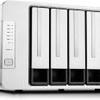Introduction
TerraMaster F5-422 5 bay NAS
Today, we'll take a look at the TerraMaster F5-422 5-bay NAS. TerraMaster is a network storage solutions provider. On the inside of that box, you'll discover an Intel Celeron J3455 Quad-Core 1.5~2.3 GHz CPU, 4GB RAM, two 1 Gigabit Ethernet ports, and a 10 Gigabit Ethernet connector. Spicy specs. Today's tested model NAS unit has five HDD bays (hot-swappable) that are RAID 0/1/5/6/10 and JBOD compatible. The MSRP of the item under review is 549 USD.
So, what do we have on our hands? The F5-221 is capable of supporting a total of 90 TB of storage capacity spread out over five 18TB HDDs if you want it, which should be sufficient not only for the home user I guess. The TerraMaster F5-422 is powered by an Intel Celeron quad-core processor running an all-core 1.5 GHz with two core 2.2 GHz and one core 2.3 Ghz clock frequency. You'll find it equipped with a 10 Gb Ethernet port as well as two 1,000 Mbps Ethernet ports, which allow for network aggregation to be supported. Reading and writing data at speeds of up to 670 MB/s are possible as well as 4K transcoding. granted, that 670 MB/sec is a little odd, as in theory at 10 Gbps you should be able to be faster. It seems max perf is just over 5 Gigabit.
This NAS is particularly well suited to professional users in the field of video editing, as well as those who work with big amounts of data and have high-performance needs. Onboard you will find one ddr3l memory modules at 4 GB, with an option for up to 8GB DRAM installed.
The TerraMaster F5-422 is the company's first NAS to use 10-Gigabit Ethernet, which allows for extremely rapid data transfer. The TOS (operating system) for the NAS has also been enhanced. The TerraMaster is equipped with an AQC107 NBase-T chip from Aquantia (now Marvell). Due to the fact that it appears to be connected through only two PCIe lanes, the PCI throughput is limited to around 8 Gbit/s though. If you want to utilize the F5-422 as a microserver, you can remove the device's inbuilt USB stick and start it from an external USB stick instead.
A NAS is used for more than merely storing files, I like to label them as micro-server. You can use them as a mail/web server, media/streaming server, or FTP server, and so much more thanks to applications you can use. Create and delete folders and shares, as well as upload data from external sources, are all accomplished through the File Manager. Choosing the Applications icon brings you to a screen containing 75 apps, including more than a dozen backup software, multimedia server apps such as iTunes Server and Plex Server, a number of security tools, and a variety of other business and utility applications. In comparison, the Asustor AS5304T comes with more than 280 applications, while the Synology DS1019+ comes with 130 applications.
The F5-422 is capable of handling a wide range of tasks, with MySQL (MariaDB) support included. The NAS can be controlled by desktop apps (PC/MAC) that use a Linux-based graphical user interface (GUI). Monitoring the NAS can also be accomplished through the use of Android and iOS applications. I'll be putting this product through its paces with a pair of SSD drives that I had sitting around. Terra Master lists a range of different drives from various vendors that are ideal for use in a NAS environment, so it would be best to follow their recommendation for long-term reliability.
|
Terra Master F5-422 |
|
| connections | 3 × RJ45, 2 × USB 2.0 (internal), 2 × USB 3.0, HDMI 2.0 |
| CPU / RAM | Celeron J3455 / 4 GB DDR3L (max. 8 GB) |
| price | 549 USD / 569 EUR |
If you decide to add HDD, power consumption can rise towards 50 Watts, however, can drop below 10 watts because of the device's 10-minute 'duty cycle' capability, if the disks inside the NAS are idle for more than 10 minutes, they will automatically go to sleep. This should help to minimize power usage and noise while also extending the life of the drives. The Windows Access Control List, which is built into the operating system, manages file permissions (ACL). There are a number of different file protocols that are supported, including the following:
- SAMBA
- AFP
- NFS
- FTP
- WebDAV
Remote access is possible with the use of TNAS or DDNS. Additionally, you have the option of setting up a personal cloud drive to meet your distant access requirements if necessary. Employees, relatives, and friends can all have access to your cloud storage space, and with the ability for two-way sync cloud drive, taking advantage of the convenience of cloud living has never been simpler. Dropbox, ElephantDrive, and Baidu Cloud are all examples of services that can be used. The features appear to be highly remarkable at first glance, and this is true. Let's put it all into practice and see how it goes.


